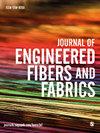Construction of grid color mixture model of seven primary-color and modified Stearns-Noechel color matching algorithm for color prediction of full-color-gamut rotor melange yarn
IF 2.3
4区 工程技术
Q1 MATERIALS SCIENCE, TEXTILES
引用次数: 0
Abstract
In this paper, the full-color-gamut grid color mixture model containing 601 grid points is constructed by ternary double coupling blending of seven primary-color fibers, and the spinning method of full-color-gamut melange yarn is given by combining with three-channel NC rotor spinning technology. A modified S-N color prediction model was constructed by selecting 55 uniformly distributed grid points for yarn and fabric production from the full-color-gamut grid color mixture model as samples for solving the reflectance conversion coefficients. On this basis, the method of predicting the color value of a melange yarn based on its primary-color fiber composition and blending ratio and predicting the primary-color fiber composition and blending ratio based on the color value of a melange yarn using the parameters of the nearest sample grid point is proposed, and six samples with different blending ratios in six color mixing regions of the full-color-gamut grid color mixture model are designed for validation. The results showed that the average color difference between the predicted color and the actual color of the melange yarn is 1.15, the predicted primary-color fiber composition of the melange yarn is consistent with the actual composition, and the average error between the predicted blending ratio and the actual blending ratio is 3.95%. The method proposed in this paper can effectively predict the color value and blending ratio of melange yarn.构建七基色网格混色模型及改进的Stearns-Noechel配色算法用于全色域转子混色纱颜色预测
本文通过7种原色纤维的三元双耦合共混,构建了包含601格点的全色域网格混色模型,并结合三通道数控转子纺纱技术,给出了全色域混色纱的纺纱方法。从全色域网格颜色混合模型中选取55个均匀分布的纱线和织物生产网格点作为样本,求解反射率转换系数,构建改进的S-N颜色预测模型。在此基础上,提出了基于混纺纱原色纤维组成和混纺纱混纺比预测混纺纱原色值和基于最近样本网格点参数预测混纺纱原色组成和混纺纱混纺比的方法,并在全色域网格混纺纱模型的6个混色区域设计了6个不同混纺比的样本进行验证。结果表明:混纺纱的预测颜色与实际颜色的平均色差为1.15,混纺纱的原色纤维组成预测与实际组成一致,混纺纱的预测混纺比与实际混纺比的平均误差为3.95%。本文提出的方法能有效地预测混纺纱的色值和混纺纱的混纺率。
本文章由计算机程序翻译,如有差异,请以英文原文为准。
求助全文
约1分钟内获得全文
求助全文
来源期刊

Journal of Engineered Fibers and Fabrics
工程技术-材料科学:纺织
CiteScore
5.00
自引率
6.90%
发文量
41
审稿时长
4 months
期刊介绍:
Journal of Engineered Fibers and Fabrics is a peer-reviewed, open access journal which aims to facilitate the rapid and wide dissemination of research in the engineering of textiles, clothing and fiber based structures.
 求助内容:
求助内容: 应助结果提醒方式:
应助结果提醒方式:


